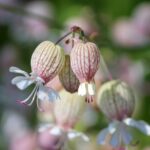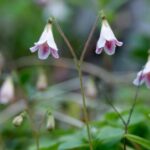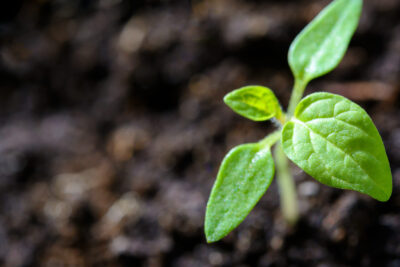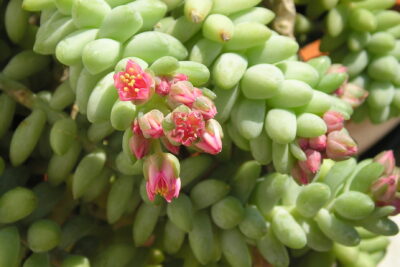
Discover the Stunning Flowering Succulents that Transform Gardens

Succulents have become increasingly popular in gardens around the world due to their unique beauty and low maintenance requirements. These plants are known for their ability to store water in their leaves, stems, and roots, allowing them to survive in arid environments. While many people associate succulents with cacti, there is a wide variety of succulent species that produce stunning flowers in addition to their fleshy leaves. These flowering succulents can add a burst of color and vibrancy to any garden, making them a favorite among gardening enthusiasts.
We will explore some of the most stunning flowering succulents that can transform gardens into breathtaking displays of color and texture. We will discuss the different types of flowering succulents available, including the popular Echeveria, Aloe, and Kalanchoe varieties. Additionally, we will provide tips on how to care for these plants, including the ideal growing conditions and watering requirements. Whether you are a seasoned gardener looking to expand your succulent collection or a beginner looking to add some beauty to your garden, this article will provide you with the information you need to create an eye-catching succulent display.
- Plant a variety of colorful succulents to add beauty to your garden
- Choose succulents that have vibrant flowers for a stunning display
- Create a succulent garden to showcase the different flowering varieties
- Use succulents with different bloom times to ensure continuous flowering
- Provide proper care and maintenance to keep your succulents blooming
- Incorporate succulents with different heights and textures for visual interest
- Combine flowering succulents with other plants to create a diverse garden
- Experiment with different planting arrangements to create unique flower displays
- Consider the climate and growing conditions to select the right succulents for your garden
- Enjoy the vibrant colors and unique blooms of flowering succulents in your garden
- Planting a variety of colorful succulents will add beauty to your garden
- Succulents with vibrant flowers can be chosen to create a stunning display
- Creating a succulent garden will showcase the different flowering varieties
- Ensuring continuous flowering can be achieved by using succulents with different bloom times
- Proper care and maintenance will keep your succulents blooming
- Visual interest can be added by incorporating succulents with different heights and textures
- A diverse garden can be created by combining flowering succulents with other plants
- Unique flower displays can be achieved by experimenting with different planting arrangements
- The right succulents for your garden can be selected by considering the climate and growing conditions
- Enjoying the vibrant colors and unique blooms of flowering succulents in your garden is possible
- Frequently Asked Questions
Plant a variety of colorful succulents to add beauty to your garden
Succulents are not only known for their unique and interesting shapes, but also for their stunning flowering capabilities. These plants, with their fleshy leaves and ability to store water, have adapted to thrive in various environments, making them an ideal addition to any garden.
When it comes to adding color and vibrancy to your garden, flowering succulents are a great choice. Their bright and cheerful blooms can instantly transform any outdoor space into a captivating oasis.
Here are some stunning flowering succulents that you should consider planting:
- Aloe Vera (Aloe barbadensis): Known for its medicinal properties, Aloe Vera also produces beautiful orange, tubular flowers that attract pollinators. Its spiky leaves and vibrant blooms make it a striking addition to any garden.
- Echeveria (Echeveria spp.): With its rosette-shaped foliage and stunning array of pastel-colored flowers, Echeveria is a popular choice among succulent enthusiasts. These low-maintenance plants are perfect for adding pops of color to rock gardens or containers.
- Kalanchoe (Kalanchoe blossfeldiana): Kalanchoe is known for its long-lasting and vibrant flowers in shades of red, orange, pink, and yellow. These small, compact succulents are perfect for borders, rock gardens, or as potted plants.
- Crassula (Crassula spp.): Crassula, commonly known as Jade Plant, features small, star-shaped flowers in shades of white or pink. With its thick, glossy leaves, this succulent adds a touch of elegance to any garden.
- Sedum (Sedum spp.): Sedums are versatile succulents that come in a wide range of shapes, sizes, and colors. They produce clusters of tiny flowers in shades of yellow, pink, and white, attracting butterflies and bees to your garden.
By incorporating these stunning flowering succulents into your garden, you can create a visually appealing and low-maintenance outdoor space. Whether you choose to plant them in the ground, in containers, or as part of a succulent arrangement, these beauties are sure to make a statement.
Remember to provide your succulents with well-draining soil, ample sunlight, and occasional watering to ensure their healthy growth and blooming. With a little care, you'll be able to enjoy the colorful and captivating flowers of these stunning succulents for years to come.
 Popular Indoor Succulents: Common Varieties for Your Home!
Popular Indoor Succulents: Common Varieties for Your Home!Choose succulents that have vibrant flowers for a stunning display
When it comes to adding a touch of beauty and color to your garden, succulents are an excellent choice. These hardy plants not only thrive in arid conditions but also produce stunning flowers that can transform any outdoor space. If you're looking to create a visually captivating garden, choosing succulents with vibrant flowers is a must.
Why opt for flowering succulents?
While succulents are commonly known for their ability to store water in their leaves and stems, many people are unaware of their flowering capabilities. Flowering succulents not only add an element of surprise and uniqueness to your garden, but they also attract pollinators such as bees and butterflies, contributing to the overall health and biodiversity of your outdoor space.
Top flowering succulents to consider
- Echeveria elegans: Known for its stunning rosette-shaped foliage, this succulent produces bell-shaped flowers in shades of pink, orange, and yellow. It adds a pop of color and elegance to any garden.
- Kalanchoe blossfeldiana: With its vibrant clusters of small, colorful flowers, this succulent is a showstopper. It comes in various shades, including red, orange, yellow, and pink, and can bloom for several weeks.
- Aloe vera: Apart from its numerous health benefits, aloe vera also produces tall spiky flowers in shades of yellow, orange, and red. The flowers attract hummingbirds, making it a delightful addition to your garden.
- Sedum spectabile: Also known as "Autumn Joy," this succulent features clusters of pink flowers that gradually turn to a deep shade of red. It blooms during late summer and is a favorite among pollinators.
Caring for flowering succulents
While succulents are generally low-maintenance plants, providing the right care is crucial to ensure their vibrant flowers continue to thrive. Here are a few tips:
- Choose the right location: Most flowering succulents prefer bright, indirect light. Place them in a spot that receives ample sunlight to promote healthy flower growth.
- Water sparingly: Succulents are drought-tolerant plants, so overwatering can lead to root rot. Allow the soil to dry out completely between waterings, and ensure proper drainage in the planting container.
- Fertilize appropriately: Use a balanced, water-soluble fertilizer specifically formulated for succulents. Apply it sparingly during the growing season to provide essential nutrients for flower production.
- Prune as needed: Remove spent flowers and trim any dead or damaged foliage to maintain the plant's overall health and appearance.
By incorporating flowering succulents into your garden, you can create a visually stunning and vibrant outdoor space. With their unique shapes, colors, and ability to thrive in various environments, these plants are sure to captivate the attention of both you and your guests.
Create a succulent garden to showcase the different flowering varieties
When it comes to creating a stunning garden, succulents are an excellent choice. These unique plants not only add a touch of beauty but also require minimal maintenance. One of the most captivating aspects of succulents is their ability to produce beautiful flowers that can transform any garden into a colorful oasis.
Why choose flowering succulents?
Flowering succulents are a popular choice among garden enthusiasts due to their vibrant and eye-catching blooms. Unlike traditional flowers, succulent flowers come in a wide range of shapes, sizes, and colors, making them a versatile addition to any garden. Whether you prefer bold and bright hues or subtle pastel tones, there is a flowering succulent for every taste.
 Discover the Most Popular Arctic Ice Succulent Varieties
Discover the Most Popular Arctic Ice Succulent VarietiesPopular flowering succulents
There are numerous flowering succulents to choose from, each with its unique characteristics and appeal. Here are some of the most popular ones:
- Echeveria: Known for their rosette-shaped leaves, Echeverias produce stunning flowers in shades of pink, red, orange, and yellow.
- Kalanchoe: With their vibrant clusters of small flowers, Kalanchoes offer a burst of color in the garden. They come in various shades, including red, orange, and yellow.
- Aloe: Aloes are not only known for their medicinal properties but also for their striking flowers. These tubular-shaped blooms can be seen in shades of red, orange, and yellow.
- Sedum: Sedums are known for their fleshy leaves and star-shaped flowers that bloom in shades of pink, purple, and white.
How to care for flowering succulents
Caring for flowering succulents is relatively easy. Here are some essential tips to keep in mind:
- Provide ample sunlight: Most succulents thrive in bright, indirect sunlight. Place them in an area where they can receive at least six hours of sunlight per day.
- Water sparingly: Succulents are drought-tolerant plants and do not require frequent watering. Allow the soil to dry out completely between waterings to prevent root rot.
- Use well-draining soil: Succulents prefer soil that drains well to avoid excess moisture. Choose a potting mix specifically formulated for succulents or amend regular potting soil with sand or perlite.
- Protect from extreme temperatures: While succulents can tolerate a wide range of temperatures, it's best to protect them from extreme heat or cold. Consider moving them indoors during harsh weather conditions.
- Fertilize sparingly: Succulents have low nutrient requirements. Apply a balanced, water-soluble fertilizer diluted to half strength once or twice a year during the growing season.
By following these simple care tips, your flowering succulents will thrive and continue to beautify your garden for years to come.
Use succulents with different bloom times to ensure continuous flowering
If you want to create a stunning garden full of vibrant colors and textures, incorporating flowering succulents is a must. These unique plants not only offer striking foliage but also produce beautiful blooms that can transform any outdoor space into a botanical paradise. One key tip to maximize the visual impact of your succulent garden is to choose varieties with different bloom times.
By carefully selecting succulents that flower at different times throughout the year, you can enjoy a continuous display of blossoms. This ensures that your garden remains vibrant and captivating no matter the season. Whether you prefer delicate pastel flowers or bold, vibrant hues, there are flowering succulents available to suit every aesthetic preference.
Here are some popular succulents known for their stunning blooms:
 Discover Beautiful Succulents with Bell-Shaped Flowers: A Guide
Discover Beautiful Succulents with Bell-Shaped Flowers: A Guide- 1. Echeveria elegans: Also known as Mexican snowball, this succulent produces clusters of pink, star-shaped flowers in late spring.
- 2. Kalanchoe blossfeldiana: This popular succulent boasts vibrant blooms in shades of red, orange, pink, and yellow. It typically flowers during the winter months.
- 3. Aloe vera: Known for its medicinal properties, aloe vera also produces tall spikes of orange or yellow flowers during the summer.
- 4. Sedum spectabile: Commonly known as "Autumn Joy," this succulent displays clusters of pink flowers that deepen to a rich rusty red in the fall.
- 5. Crassula ovata: Also called "Jade Plant" or "Money Tree," this succulent produces small, star-shaped white or pink flowers in late winter or early spring.
By incorporating these and other flowering succulents with varying bloom times into your garden, you can create a visually stunning and ever-changing landscape. Be sure to consider factors such as light requirements, watering needs, and climate suitability when selecting succulents for your garden.
Remember, the key to a flourishing succulent garden is to provide proper care and maintenance. With the right attention and a well-thought-out selection of flowering succulents, your garden will become a year-round source of beauty and inspiration.
Provide proper care and maintenance to keep your succulents blooming
Why choose flowering succulents?
Flowering succulents add a touch of beauty and elegance to any garden. With their vibrant colors and unique shapes, these plants are a popular choice among garden enthusiasts. Not only do they provide visual appeal, but they also attract pollinators such as bees and butterflies, contributing to a thriving ecosystem.
Factors to consider for success
To ensure your flowering succulents thrive and bloom to their fullest potential, it is essential to provide them with proper care and maintenance. Here are some key factors to consider:
- Light: Most succulents require bright but indirect sunlight to promote flowering. Place them in an area where they can receive at least six hours of sunlight each day.
- Watering: Succulents are known for their ability to store water in their leaves and stems. It is crucial to allow the soil to dry out between waterings to prevent root rot. Overwatering can hinder blooming.
- Soil: Well-draining soil is essential for succulents. Use a mixture of sandy soil and perlite or pumice to ensure proper drainage. This prevents waterlogged roots, which can lead to plant stress and hinder flowering.
- Fertilization: While succulents are low-maintenance plants, they still benefit from occasional fertilization. Use a balanced, slow-release fertilizer during the growing season to provide essential nutrients for healthy growth and blooming.
- Temperature: Most flowering succulents thrive in moderate temperatures. Avoid exposing them to extreme heat or cold, as it can impact their overall health and blooming potential.
Popular flowering succulents
There is a wide variety of flowering succulents to choose from, each with its own unique characteristics. Here are some popular options to consider for your garden:
- Echeveria: Known for their rosette-shaped foliage and vibrant flowers, Echeverias are a popular choice among succulent enthusiasts.
- Kalanchoe: With its clusters of small, colorful flowers, Kalanchoe adds a burst of color to any garden.
- Aloe: Aloe plants not only have medicinal properties but also produce stunning tubular flowers that attract hummingbirds.
- Sedum: Sedums are known for their diverse range of flower colors and their ability to tolerate various growing conditions.
- Haworthia: Haworthias produce small, intricate flowers and are a great choice for indoor gardens or partial shade areas.
By providing the right care and selecting the right flowering succulents for your garden, you can enjoy a stunning display of blooms throughout the year. Remember to research the specific needs of each succulent variety to ensure their optimal growth and blooming potential.
 Thriving Succulents: Discover Fast-Growing Varieties
Thriving Succulents: Discover Fast-Growing VarietiesIncorporate succulents with different heights and textures for visual interest
When it comes to transforming your garden into a stunning oasis, incorporating flowering succulents is a game-changer. These unique plants not only add vibrant pops of color, but they also provide a low-maintenance option for even the most novice of gardeners. One of the key design principles to keep in mind when working with succulents is to mix and match varieties with different heights and textures. This will create visual interest and make your garden truly stand out.
Choosing Succulents with Varying Heights
To achieve a visually appealing succulent garden, it's important to select plants that range in height. This will add dimension and depth to your landscape. Consider incorporating tall succulents like Aloe Vera or Agave as focal points in your garden. These vertical elements will draw the eye and create a sense of balance. Mix them with shorter succulents such as Echeveria or Sedum to create a layered effect.
Playing with Texture
Texture is another important aspect to consider when selecting succulents for your garden. By combining plants with different leaf shapes and textures, you can create a visually captivating display. For example, consider pairing succulents with spiky leaves like Haworthia with ones that have smooth, rounded leaves like Crassula. This contrast in textures will add visual interest and create a dynamic composition.
Creating Colorful Combinations
Succulents are known for their ability to produce stunning blooms in a variety of colors. When designing your garden, consider choosing succulents that will flower at different times throughout the year. This will ensure that your garden is constantly filled with vibrant colors and blooming flowers. Mix and match succulents with different bloom colors, such as the bright oranges of Kalanchoe or the soft pinks of Echeveria to create eye-catching combinations.
The Importance of Balance
As with any garden design, achieving balance is crucial. When incorporating succulents with different heights and textures, make sure to distribute them evenly throughout your garden. This will create a sense of equilibrium and prevent any one area from appearing too crowded or sparse. By carefully considering the placement of each succulent, you can create a visually stunning and harmonious garden.
By incorporating succulents with varying heights, textures, and colors, you can transform your garden into a breathtaking space. Experiment with different combinations and let your creativity shine. Whether you have a small balcony garden or a sprawling backyard, flowering succulents are sure to add that wow factor you've been looking for.
Combine flowering succulents with other plants to create a diverse garden
 Top Succulent Plants: Perfect Elephant Food for a Nutritious Feast
Top Succulent Plants: Perfect Elephant Food for a Nutritious FeastFlowering succulents are not only visually striking but also incredibly versatile when it comes to garden design. By combining these stunning plants with other varieties, you can create a diverse and captivating garden that will surely be the envy of your neighbors.
One of the best ways to incorporate flowering succulents into your garden is by planting them alongside other plants with contrasting textures and colors. This contrast will add depth and visual interest to your outdoor space.
Why choose flowering succulents?
Flowering succulents, such as Echeveria, Kalanchoe, and Aloe, offer a unique blend of beauty and resilience. These plants have adapted to survive in arid climates, making them low-maintenance and drought-tolerant. In addition to their hardiness, many succulents produce vibrant flowers that can brighten up any garden.
When selecting flowering succulents for your garden, consider their growth habits, bloom colors, and sizes. This will help you create a cohesive and visually appealing arrangement.
Pairing flowering succulents with other plants
When it comes to combining flowering succulents with other plants, the possibilities are endless. Here are a few ideas to get you started:
- Contrast in color: Pair succulents with brightly colored flowers, such as Geraniums or Petunias, for a bold and vibrant display.
- Textural variety: Mix succulents with plants that have different leaf shapes and textures, such as ornamental grasses or ferns, to create an intriguing visual contrast.
- Height variation: Combine taller succulents, like Agave or Yucca, with shorter flowering plants, such as Marigolds or Zinnias, to create a dynamic and layered garden bed.
Remember to consider the lighting requirements and water needs of the plants you choose to ensure they thrive together. Grouping plants with similar care needs will make maintenance easier and ensure the overall health of your garden.
Creating a focal point
Flowering succulents can also be used as a focal point in your garden. Consider planting a large, eye-catching succulent variety, like Aeonium or Sedum, in a decorative pot or at the center of a flower bed. Surround it with complementary plants to enhance its beauty and draw attention to the area.
 Discover Low-Maintenance Bush-Like Plants That Resemble Succulents
Discover Low-Maintenance Bush-Like Plants That Resemble SucculentsWhether you're a seasoned gardener or just starting, incorporating flowering succulents into your garden design will undoubtedly elevate its appeal. Their stunning blooms and unique forms will add a touch of elegance and charm to any outdoor space. So go ahead, experiment with different combinations, and discover the breathtaking beauty of flowering succulents!
Experiment with different planting arrangements to create unique flower displays
When it comes to transforming your garden into a stunning, eye-catching oasis, flowering succulents are a must-have addition. These versatile plants not only bring a burst of color and beauty to your outdoor space but also require minimal maintenance.
One of the great advantages of flowering succulents is their ability to thrive in different planting arrangements. Whether you prefer a structured, organized garden or a more natural, wild look, these plants can be arranged to suit your style.
1. Vertical Gardens
Create a dramatic focal point by incorporating flowering succulents into a vertical garden. Use a variety of succulent species with different bloom times to ensure a constant display of vibrant colors throughout the year.
Consider using a mix of trailing succulents, such as Sedum morganianum (Burro's Tail) and Senecio radicans (String of Bananas), along with upright varieties like Echeveria elegans (Mexican Snowball) and Kalanchoe blossfeldiana (Flaming Katy). Arrange them in a way that allows each plant to receive sufficient sunlight and space to grow.
2. Flowering Succulent Borders
Create a stunning border along pathways or garden beds by planting flowering succulents in a linear arrangement. Choose succulents with similar blooming periods to ensure a continuous display of flowers.
Some popular options for flowering succulent borders include Aloe arborescens (Torch Aloe), Crassula ovata (Jade Plant), and Portulaca grandiflora (Moss Rose). Their vibrant blooms and unique foliage will add a touch of elegance to your garden.
 Top Yellow Flowering Succulent Ground Cover Options for Your Garden
Top Yellow Flowering Succulent Ground Cover Options for Your Garden3. Mixed Succulent Containers
For a more eclectic look, consider creating mixed succulent containers. Combine different succulent species with contrasting colors, textures, and growth habits to create visually appealing displays.
Choose a variety of flowering succulents such as Aeonium arboreum (Black Rose), Echeveria 'Perle von Nurnberg', and Graptopetalum paraguayense (Ghost Plant). Play around with different container sizes, shapes, and heights to add dimension to your arrangement.
Remember to group succulents with similar water and light requirements together to ensure their optimal growth and health.
With these different planting arrangements, you can experiment and create unique flower displays that will transform your garden into a stunning oasis. The versatility and beauty of flowering succulents make them a top choice for any garden enthusiast.
So, why wait? Get started on your succulent gardening adventure today and enjoy the vibrant blooms and low-maintenance beauty that these plants bring to your outdoor space.
Consider the climate and growing conditions to select the right succulents for your garden
When it comes to incorporating succulents into your garden, it's essential to consider the climate and growing conditions of your specific location. Succulents are known for their ability to thrive in arid and dry environments, making them an excellent choice for gardens in hot and sunny regions.
 Dramatic Succulents: Discover the Varieties with Striking, Long Leaves
Dramatic Succulents: Discover the Varieties with Striking, Long LeavesHowever, not all succulents are created equal, and some species may have specific temperature or moisture requirements. Before selecting the succulents for your garden, research the hardiness zones and average temperatures of your area to ensure the plants you choose can withstand the climate.
Additionally, take into account the growing conditions of your garden, such as the amount of sunlight and soil type. Succulents generally prefer well-draining soil and full sun exposure. If your garden has a different light condition or heavy clay soil, you may need to make adjustments or opt for succulents that are more adaptable to those conditions.
Remember, succulents are incredibly diverse, with a wide range of shapes, sizes, and colors to choose from. By taking into consideration the climate and growing conditions, you can select the right succulents that will not only survive but thrive in your garden.
Enjoy the vibrant colors and unique blooms of flowering succulents in your garden
Why Choose Flowering Succulents for Your Garden?
Flowering succulents, also known as succulent plants or simply succulents, are a fantastic addition to any garden. These stunning plants not only offer vibrant colors and unique blooms, but they are also low-maintenance and drought-tolerant.
Unlike traditional flowers, which require constant watering and maintenance, flowering succulents have adapted to survive in arid conditions. This means that they can thrive in gardens with minimal watering, making them perfect for busy gardeners or those living in dry climates.
The Beauty of Flowering Succulents
One of the most captivating aspects of flowering succulents is their remarkable beauty. These plants come in a wide variety of shapes, sizes, and colors, making them a versatile choice for any garden.
 Best Heat-Resistant Succulents: Thriving in High Temperatures
Best Heat-Resistant Succulents: Thriving in High TemperaturesFrom the stunning red and orange hues of the Echeveria 'Afterglow' to the delicate pink flowers of the Kalanchoe blossfeldiana, there is a flowering succulent to suit every taste and garden aesthetic.
Additionally, many flowering succulents produce striking blooms that can last for weeks or even months. This extended blooming period ensures that your garden remains vibrant and colorful throughout the seasons.
How to Incorporate Flowering Succulents into Your Garden
Integrating flowering succulents into your garden is a breeze. These plants can be planted in containers, beds, or even rock gardens, allowing for endless possibilities when it comes to garden design.
If you prefer a more structured look, consider planting flowering succulents in neat rows or patterns. This will create a visually appealing display that highlights the unique shapes and colors of each plant.
Alternatively, you can mix different types of succulents together to create a more natural, organic feel. This approach allows the plants to intertwine and create a visually stunning tapestry of colors and textures.
Top Flowering Succulents to Consider
When choosing flowering succulents for your garden, it's essential to select varieties that are well-suited to your climate and growing conditions. Here are some popular choices to consider:
- Echeveria 'Afterglow': This succulent features rosettes of pale lavender leaves with a hint of pink and produces bright coral flowers.
- Kalanchoe blossfeldiana: Known for its small, vibrant pink flowers, this succulent is a popular choice for adding a pop of color to any garden.
- Aloe dorotheae: With its bright orange flowers and compact size, this succulent is perfect for adding a touch of tropical beauty to your garden.
- Crassula ovata: Also known as the Jade plant, this succulent produces clusters of white or pink flowers and is highly adaptable to different growing conditions.
Flowering succulents offer a unique and beautiful alternative to traditional flowers in your garden. Their vibrant colors, unique blooms, and low-maintenance nature make them a perfect choice for any gardener.
 Explore Stunning Tri Color Succulents: Discover Vibrant Varieties!
Explore Stunning Tri Color Succulents: Discover Vibrant Varieties!So why not add some stunning flowering succulents to your garden and enjoy the beauty they bring all year round?
Planting a variety of colorful succulents will add beauty to your garden
When it comes to gardening, succulents have become increasingly popular for their low maintenance and unique appearance. These stunning plants come in a variety of shapes, sizes, and colors, making them a perfect choice for transforming any garden into a vibrant oasis.
One of the most captivating features of succulents is their ability to produce beautiful flowers. Contrary to popular belief, not all succulents are solely known for their foliage. Many species have evolved to bloom with stunning flowers, adding an extra layer of visual interest to your garden.
Here are some stunning flowering succulents that are sure to make a statement in your garden:
- Echeveria elegans: This succulent produces rosettes of powdery blue-green leaves and delicate pink flowers. The contrast between the foliage and the vibrant blooms creates a striking display.
- Aloe vera: Known for its medicinal properties, Aloe vera also boasts beautiful orange or yellow tubular flowers. These flowers attract hummingbirds and butterflies, adding a touch of life to your garden.
- Kalanchoe blossfeldiana: With its vibrant red, pink, yellow, or orange flowers, this succulent is a showstopper. The compact and densely clustered blooms create a visually stunning effect.
Not only do these flowering succulents add a splash of color to your garden, but they also attract pollinators such as bees and butterflies, contributing to the overall health of your outdoor space.
When incorporating flowering succulents into your garden, it's important to consider their specific needs. Most succulents thrive in well-draining soil and require plenty of sunlight. However, each species may have unique care requirements, so it's essential to research and provide the ideal conditions for your chosen plants.
By adding these stunning flowering succulents to your garden, you can create a visually captivating and low-maintenance space that will be the envy of your neighbors. So, get ready to transform your garden into a breathtaking oasis with these beautiful plants!
Succulents with vibrant flowers can be chosen to create a stunning display
When it comes to transforming gardens and adding a pop of color, flowering succulents are an excellent choice. These stunning plants not only offer unique shapes and textures but also produce vibrant blooms that can make any garden come alive.
One of the key advantages of using flowering succulents is their ability to thrive in dry and arid conditions. As succulents store water in their leaves, they are adapted to survive in environments with minimal rainfall. This makes them perfect for gardens in regions with hot and arid climates or for those who prefer low-maintenance plants.
Types of Flowering Succulents
There is a wide variety of flowering succulents available, each with its own unique characteristics and blooms. Some popular options include:
- Kalanchoe: These succulents are known for their clusters of small, colorful flowers that come in shades of red, pink, orange, and yellow. They add a vibrant touch to any garden.
- Aloe: Aloe vera is a well-known succulent that not only offers medicinal benefits but also produces tall spikes of tubular flowers. Their vibrant colors and architectural structure make them a stunning addition to any garden.
- Echeveria: With their rosette-shaped leaves, echeverias are one of the most popular succulents. They produce beautiful bell-shaped flowers in various colors, including shades of pink, orange, and yellow.
- Agave: Agave plants are known for their bold and architectural appearance. While they are primarily grown for their unique foliage, some varieties produce impressive flower spikes that can reach several feet in height.
These are just a few examples, and there are many more flowering succulents to choose from. The key is to select varieties that are suitable for your climate and garden conditions.
Caring for Flowering Succulents
While flowering succulents are relatively low-maintenance, they still require proper care to ensure their health and longevity. Here are some essential care tips:
- Light: Most flowering succulents thrive in bright, indirect light. However, it's crucial to avoid exposing them to intense, direct sunlight, as this can cause sunburn and damage the leaves.
- Watering: Succulents have unique watering needs. They prefer to be watered thoroughly but infrequently. Allow the soil to dry out completely between watering sessions to prevent root rot.
- Soil: Well-draining soil is essential for succulents. Use a specialized succulent or cactus mix that allows excess water to escape quickly.
- Fertilizer: While succulents don't require frequent fertilization, you can use a balanced, diluted fertilizer during the growing season to promote healthy growth and blooming.
By following these care guidelines, you can ensure that your flowering succulents thrive and continue to grace your garden with their stunning blooms.
Flowering succulents are a fantastic addition to any garden. Their unique shapes, textures, and vibrant blooms can completely transform a space. Whether you live in a hot and arid climate or simply appreciate low-maintenance plants, consider incorporating these stunning succulents into your garden for a visually striking display.
Creating a succulent garden will showcase the different flowering varieties
Succulents are known for their unique and exotic appearance, but did you know that some succulents also produce stunning flowers? Creating a succulent garden is not only a great way to add a touch of natural beauty to your outdoor space, but it also allows you to showcase the diverse range of flowering succulents available.
When planning your succulent garden, it's important to consider the different types of succulents that produce flowers. While not all succulents flower, there are plenty of varieties that do, and they can add a burst of vibrant color to your garden.
Here are some stunning flowering succulents to consider:
- Echeveria elegans: This popular succulent features rosettes of pale blue-green leaves and produces beautiful pink or coral flowers in the spring.
- Aloe vera: Known for its medicinal properties, Aloe vera also produces tall stalks of vibrant orange or yellow flowers.
- Kalanchoe blossfeldiana: This compact succulent is a favorite among gardeners for its clusters of small, colorful flowers that range from red and pink to orange and yellow.
- Hoya carnosa: Also known as the wax plant, this succulent produces clusters of star-shaped flowers that are highly fragrant and can range in color from white to pink.
These are just a few examples of the many flowering succulents that you can incorporate into your garden. By carefully selecting a variety of succulents with different flowering times and colors, you can create a garden that will bloom throughout the year.
When it comes to caring for flowering succulents, it's important to provide them with the right conditions. Most succulents prefer well-draining soil, plenty of sunlight, and minimal watering. It's also important to keep an eye out for any pests or diseases that can affect the health of your plants.
Whether you're a seasoned gardener or just starting out, incorporating flowering succulents into your garden is a fantastic way to add visual interest and create a unique and beautiful outdoor space. So why not explore the world of flowering succulents and transform your garden into a stunning showcase of nature's beauty?
Ensuring continuous flowering can be achieved by using succulents with different bloom times
One of the most enchanting aspects of succulents is their ability to produce stunning flowers. These flowering succulents not only add a burst of color to your garden but also attract pollinators like bees and butterflies.
Ensuring continuous flowering in your garden can be achieved by strategically selecting succulents with different bloom times. By incorporating a variety of succulents that flower at different seasons, you can maintain a vibrant and visually appealing garden all year round.
Here are some of the most popular flowering succulents:
- 1. Echeveria - Known for their rosette-shaped foliage, Echeverias produce beautiful bell-shaped flowers in shades of pink, orange, and yellow. These succulents typically bloom in the spring and summer.
- 2. Sedum - Sedums are versatile succulents that come in various shapes and sizes. They produce clusters of star-shaped flowers in vibrant hues such as red, pink, and white. Some Sedum varieties bloom in late summer and early fall.
- 3. Kalanchoe - Kalanchoes are popular for their long-lasting and vibrant blooms. These succulents feature clusters of small, tubular flowers in shades of red, orange, and yellow. They often bloom in the winter and early spring.
- 4. Aloe - Besides their medicinal properties, Aloes also display attractive tubular flowers on tall stalks. These flowers can range from yellow to orange and bloom during the winter and spring months.
- 5. Crassula - Crassulas, also known as Jade plants, produce clusters of small, star-shaped flowers in shades of pink, white, and red. These succulents typically bloom in late winter and early spring.
By incorporating these flowering succulents into your garden, you can create a captivating display of colors and textures. Don't forget to provide them with the proper care, including adequate sunlight, well-draining soil, and occasional watering, to ensure their optimal blooming potential.
Proper care and maintenance will keep your succulents blooming
Proper watering
One of the key aspects of caring for flowering succulents is to ensure they receive the right amount of water. Succulents store water in their leaves and stems, so it's important not to overwater them. A good rule of thumb is to water them deeply, allowing the soil to dry out completely between waterings. Be careful not to let them sit in standing water, as this can lead to root rot.
Providing adequate sunlight
Succulents thrive in bright, indirect sunlight. Place them near a window or in an area that receives at least six hours of sunlight per day. However, be cautious of intense, direct sunlight as it can scorch the leaves of your succulents. If you notice signs of sunburn, such as brown spots or bleached patches, move your succulents to a slightly shadier spot.
Fertilizing for optimal growth
While succulents generally don't require frequent fertilizing, applying a balanced, low-nitrogen fertilizer can help promote healthy growth and encourage blooming. Use a diluted fertilizer once a month during the growing season, following the instructions on the packaging. Avoid over-fertilizing, as this can lead to leggy growth and reduce the chances of flowering.
Choosing the right soil
Succulents prefer well-draining soil to prevent waterlogged roots. Use a specialized succulent or cactus potting mix that contains a combination of sand, perlite, and peat moss. This type of soil allows excess water to drain away quickly, preventing root rot. Avoid using regular potting soil, as it tends to retain too much moisture for succulents.
Pruning and deadheading
To encourage continuous blooming and maintain the overall shape of your succulents, regular pruning is essential. Use clean, sharp scissors or pruning shears to remove any dead or faded flowers. This process, known as deadheading, redirects the plant's energy towards producing new blooms. Additionally, you can trim any leggy or overgrown stems to promote a fuller, more compact appearance.
Protecting from extreme temperatures
Succulents are generally hardy plants that can withstand a range of temperatures. However, extreme heat or cold can cause stress and damage to their delicate blooms. If you live in an area with harsh summers, consider providing some shade during the hottest parts of the day. Similarly, during cold winters, move your succulents indoors or provide them with protection, such as covering them with frost cloth, to prevent frost damage.
Enjoy the beauty of flowering succulents
With the right care and maintenance, your succulents can transform your garden with their stunning blooms. By following these tips, you can ensure that your succulents remain healthy, vibrant, and continuously produce beautiful flowers for you to enjoy.
Visual interest can be added by incorporating succulents with different heights and textures
Succulents are not only known for their ability to store water, but also for their stunning flowering displays. By incorporating succulents with different heights and textures, you can add visual interest to your garden and create a beautiful transformation.
One of the most eye-catching aspects of flowering succulents is their diverse range of colors. From vibrant pinks and purples to soft pastels and even bold oranges, succulents offer a wide array of hues that can complement any garden color scheme. Whether you prefer a monochromatic look or a mix of vibrant colors, there is a flowering succulent out there for you.
In addition to their vibrant colors, flowering succulents also come in a variety of shapes and sizes. Some succulents produce large, showy blooms that can become a focal point in your garden. Others have delicate, intricate flowers that add a touch of elegance. By mixing succulents with different flower shapes and sizes, you can create a visually dynamic garden that is sure to impress.
Choosing the right succulents for your garden
When selecting flowering succulents for your garden, it's important to consider their specific care requirements. Some succulents thrive in full sun, while others prefer partial shade. It's also important to consider the climate in your area and choose succulents that are suited to your region's temperature and rainfall patterns.
Another factor to consider is the size of your garden and the available space for your succulents to grow. Some succulents can spread out and fill in large areas, while others stay compact and are better suited for smaller spaces. By understanding the growth habits of different succulents, you can ensure that you choose the right plants for your garden.
Arranging succulents for maximum impact
When arranging succulents in your garden, consider their heights and textures. By mixing tall, upright succulents with low-growing, trailing varieties, you can create a visually appealing display that adds depth and dimension to your garden.
Grouping succulents with similar heights and textures together can also create a cohesive and harmonious look. For example, you can create a rock garden by grouping succulents with spiky textures and arranging them among rocks and pebbles. On the other hand, pairing succulents with soft, rounded textures can create a more calming and soothing atmosphere.
Flowering succulents have the power to transform any garden into a stunning visual display. By carefully selecting the right succulents for your garden, considering their care requirements, and arranging them strategically, you can create a garden that is not only beautiful but also low-maintenance and drought-tolerant.
A diverse garden can be created by combining flowering succulents with other plants
Flowering succulents have become increasingly popular in gardens due to their unique and stunning appearance. These plants not only add vibrant colors to any landscape but also require minimal care and maintenance.
When it comes to creating a diverse garden, incorporating flowering succulents can be a game-changer. Their ability to thrive in various climates and soil conditions makes them a versatile choice for both beginners and experienced gardeners.
Why choose flowering succulents?
Flowering succulents, also known as succulent perennials, offer a wide range of benefits that make them an excellent addition to any garden:
- Visual appeal: With their vibrant and eye-catching flowers, flowering succulents can instantly transform the look and feel of your garden. Their unique shapes and colors create a striking contrast against other plants.
- Low maintenance: Succulents are known for their ability to store water in their leaves, allowing them to withstand drought conditions. This means less watering and overall minimal care.
- Longevity: Unlike annual flowers that need to be replanted each year, succulents are perennials, meaning they can last for several years with proper care.
- Adaptability: Flowering succulents can adapt to a variety of climates and soil types, making them suitable for different regions. Whether you live in a hot and arid environment or a cooler, more temperate climate, there's a succulent that will thrive in your garden.
Popular flowering succulents
There are numerous types of flowering succulents to choose from, each with its own unique characteristics. Here are some popular options:
- Echeveria: Known for its rosette-shaped leaves and vibrant flowers, Echeveria is a favorite among succulent enthusiasts. They come in various colors, including shades of pink, purple, and red.
- Aloe: Aloe plants not only offer medicinal benefits but also produce beautiful tubular flowers that attract pollinators. They are available in different sizes and colors, ranging from yellow to orange.
- Kalanchoe: This succulent produces clusters of small, colorful flowers, making it a delightful addition to any garden. They are available in shades of red, orange, pink, and yellow.
- Sedum: Sedums are known for their fleshy leaves and star-shaped flowers. They come in various sizes, from ground-covering varieties to taller, more upright species.
By incorporating these stunning flowering succulents into your garden, you can create a visually appealing and low-maintenance oasis. Whether you choose to plant them in containers, rock gardens, or mixed beds, their unique beauty is sure to captivate anyone who visits your garden.
Unique flower displays can be achieved by experimenting with different planting arrangements
When it comes to garden design, one can't underestimate the impact of stunning flowering succulents. These unique plants not only add a touch of beauty to any garden but also bring a sense of charm and elegance. With their ability to thrive in various conditions and their low maintenance requirements, succulents have become a popular choice for many garden enthusiasts.
But what sets flowering succulents apart from their non-flowering counterparts is their ability to produce vibrant blooms that can completely transform a garden. By experimenting with different planting arrangements, you can create a captivating display of colors and textures that will leave your guests in awe.
Choosing the Right Flowering Succulents
Before diving into the world of flowering succulents, it's essential to choose the right plants for your garden. Consider factors such as climate, sunlight exposure, and soil conditions to ensure the success of your succulent garden. Some popular flowering succulents include:
- Echeveria: Known for their rosette-shaped foliage and stunning flower stalks, Echeverias come in a wide range of colors, from soft pastels to vibrant pinks and purples.
- Aloe: With their distinctive spiky leaves and tall flower spikes, Aloes add a dramatic touch to any garden. They produce tubular flowers in various shades of red, orange, and yellow.
- Kalanchoe: These succulents are known for their compact growth habit and clusters of small, colorful flowers. Kalanchoes come in an array of hues, including reds, pinks, oranges, and yellows.
Creating Stunning Planting Arrangements
Once you've selected your flowering succulents, it's time to get creative with your planting arrangements. Here are a few ideas to inspire you:
- Colorful Borders: Create a vibrant border around your garden beds by planting succulents with different flower colors in a repeating pattern. The contrast of hues will make your garden come alive.
- Vertical Gardens: Use wall-mounted planters or hanging baskets to create a vertical garden display. Combine different succulent varieties with contrasting flower colors for an eye-catching arrangement.
- Rock Gardens: Succulents thrive in rocky, well-draining soil. Build a rock garden and carefully place succulents with varying bloom colors and textures among the rocks for a natural and picturesque look.
Remember to consider the growth habits and lighting needs of your succulents when planning your arrangements to ensure they thrive and bloom to their full potential. With a bit of creativity and experimentation, you can achieve stunning displays of flowering succulents that will transform your garden into a true masterpiece.
The right succulents for your garden can be selected by considering the climate and growing conditions
When it comes to adding beauty and charm to your garden, flowering succulents are an excellent choice. These stunning plants not only provide a pop of color but also require minimal care and maintenance. However, selecting the right succulents for your garden is crucial, as it depends on the climate and growing conditions.
Climate considerations
The first step in choosing flowering succulents for your garden is to consider the climate. Succulents thrive in warm and arid climates, making them perfect for gardens in desert regions. However, there are also varieties that can tolerate cooler temperatures and even frost.
If you live in a region with extreme heat or cold, it is important to choose succulents that can withstand those conditions. Some heat-tolerant succulents include Agave, Aloe, and Sedum. On the other hand, cold-hardy succulents like Sempervivum and Echeveria can survive freezing temperatures.
Growing conditions
Aside from climate, it is essential to assess the growing conditions in your garden. Succulents generally prefer well-draining soil to prevent root rot. They also require plenty of sunlight to thrive and produce vibrant blooms.
Before selecting succulents, check if your garden has the ideal sunlight exposure. Some succulents can tolerate partial shade, while others need full sun. Consider the direction and duration of sunlight in your garden to determine the best placement for your flowering succulents.
Choosing the right succulents
Once you have considered the climate and growing conditions, it's time to choose the specific succulents for your garden. There is a wide range of flowering succulents available, each with its own unique colors and shapes.
Consider the overall aesthetic you want to achieve in your garden. Are you looking for succulents with bold, vibrant flowers or ones with delicate blooms? Do you prefer succulents with compact rosettes or trailing varieties that cascade down walls or hanging baskets?
Some popular flowering succulents include Echeveria, Kalanchoe, Crassula, and Sedum. These varieties offer an array of colors, from soft pastels to vivid pinks, oranges, and purples.
Remember, incorporating flowering succulents into your garden not only adds visual appeal but also attracts pollinators like bees and butterflies. By selecting the right succulents for your climate and growing conditions, you can create a stunning and low-maintenance garden that will be the envy of your neighbors.
Enjoying the vibrant colors and unique blooms of flowering succulents in your garden is possible
Succulents are known for their ability to thrive in arid conditions and require minimal care. While most people associate succulents with their fleshy leaves and interesting shapes, many are unaware that some succulents also produce stunning flowers. These flowering succulents can add a whole new dimension to your garden, with their vibrant colors and unique blooms.
Here are some of the most breathtaking flowering succulents that you can consider adding to your garden:
1. Echeveria
Echeverias are one of the most popular succulent genera, known for their rosette-shaped leaves and charming flowers. These plants produce clusters of tubular or bell-shaped flowers in various shades of pink, orange, yellow, and red. Their blooms create a striking contrast against the fleshy green leaves, making them a focal point in any garden.
2. Kalanchoe
Kalanchoes are another group of succulents that are known for their stunning flowers. These plants have thick, waxy leaves and produce clusters of small, colorful flowers. The flowers can be found in shades of red, pink, orange, and yellow, adding a burst of color to your garden. Kalanchoes are also known for their long-lasting blooms, ensuring that your garden remains vibrant for extended periods.
3. Aloe
Aloes are not only popular for their medicinal properties but also for their remarkable flowers. These succulents produce tall flower spikes with tubular flowers in shades of orange, red, and yellow. The flowers attract hummingbirds and butterflies, adding an element of wildlife to your garden. Apart from their stunning blooms, aloes also have attractive foliage with rosettes of fleshy, spiky leaves.
4. Sedum
Sedums, also known as stonecrops, are versatile succulents that come in various shapes, sizes, and colors. Some sedums produce eye-catching flowers that range from star-shaped to clusters of tiny blooms. These flowers can be found in shades of pink, purple, white, and yellow, creating a beautiful tapestry of colors in your garden. Sedums are low-maintenance and can thrive in various climates, making them a great choice for beginners.
5. Crassula
Crassulas are a diverse group of succulents that encompass a wide range of shapes and sizes. Some crassulas produce delicate, star-shaped flowers in shades of white, pink, or red. These flowers can appear in clusters or atop long stems, creating a visually appealing display. Crassulas are known for their resilience and can tolerate both drought and neglect with ease.
By incorporating these stunning flowering succulents into your garden, you can create a visually striking and low-maintenance oasis. Whether you prefer vibrant pinks, fiery oranges, or delicate whites, there is a flowering succulent that will suit your taste. So, why not transform your garden with these captivating blooms and enjoy a colorful and unique landscape?
Frequently Asked Questions
1. What are flowering succulents?
Flowering succulents are a type of plant that belongs to the succulent family and produces beautiful flowers during their blooming season.
2. Can flowering succulents survive in different climates?
Yes, many flowering succulents are adaptable to different climates. However, it's important to choose the right species that can thrive in your specific climate.
3. How often do flowering succulents bloom?
The blooming frequency of flowering succulents can vary depending on the species. Some may bloom once a year, while others may bloom multiple times throughout the year.
4. How do I care for flowering succulents?
Flowering succulents require well-drained soil, plenty of sunlight, and minimal watering. It's important to avoid overwatering as it can lead to root rot.
If you want to read more articles similar to Discover the Stunning Flowering Succulents that Transform Gardens, you can visit the Varieties and Colors category.






You Must Read